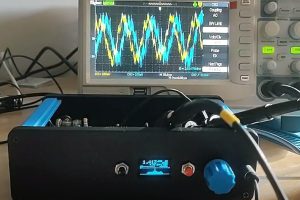Analog Devices has an output stage IC designed particularly for arbitrary waveform generators and power supplies. It is rather pricey, at $86 from Digikey, for example ($360 for the eval kit) but can driver up to ±40V, up to ±1A, and up to 1,800V/μs into 1nF. And, AD8460 includes a 14bit DAC with which to generate the waveforms. The technology ...
Tag Archives: Engineer in Wonderland
Sallen and Key filter puzzle with LTspice
I was concocting a rather silly low-pass filter design, when I remembered that Messrs Sallen and Key did it better in the 1950s, and decided to use their two-pole design to implement a Butterworth filter (thank you also Mr Butterworth). Wonderfully, there are free Sallen and Key Butterworth filter calculators on the web now – I used the one on ...
Excellent ‘free’ book on bipolar transistors (and other excellent free books too)
There is some hogwash out there, masquerading as engineering white papers, which are really just click bait to get your contact details. And there are some gems available for the same price. And, in my opinion, ‘BJT. Bipolar junction transistor application handbook‘ from Nexperia is one of the gems. The price is handing over your name, company name and email ...
Is anyone working on a pesticide sensor?
We got to hear of a citizen science project recently, where volunteers regularly sample a river and its tributaries to gather water quality information. Nitrates, for example, are measured using simple chemistry-based test kit. But pesticides need a combination of chromatography and mass spectrometry and cannot be tested in the field by an expert, let alone a citizen scientist. Part ...
Software-defined radio using a Raspberry Pi Pico
I came across a delightful design by the un-named person behind 101 Things, a blog and a YouTube channel. It is an up-to-30MHz software defined radio using a Raspberry Pi Pico for the local oscillator and… …. most of the rest of the radio. Very pleasantly, this design introduced me to a ‘Tayloe’ down-converter (after Dan Tayloe), which uses a ...
One I missed – cunning hysteric dc-dc converter
NCV30161 is a dc-dc converter intended to drive leds with a continuous current – albeit with a superimposed triangle wave. It is a buck converter – slightly up-side-down because it has its switch on the negative side. There is no output capacitor, and the inductor and the leds are in series, so they both get the same current at all ...
Raspberry Pi makes RISC-V more accessible
In choosing to put RISC-V cores on its new microcontroller – fear not, there are Arm Coretex-M33 cores too – Raspberry Pi will be helping put this architecture on the map. Proc0 and Proc1 can independently be set to be an Arm Cortex-M33 or a RISC-V core at boot Not that RISC-V is not already climbing rapidly in the instruction ...
Slightly fiddly-to-find ATtiny412 information
The delightful 8pin ATtiny412 comes in a few versions, all with 4kbyte of flash and 256byte of ram, and it takes a while to dig out the following: ATtiny412-SSNR 20MHz 1.8-5.5V -40 to +105°C tape and reel ATtiny412-SSN tube or tray ATtiny412-SSFR 16MHz 2.7-5.5V -40 to +125°C tape and reel ATtiny412-SSF tube or tray
Someone, please explain how this two-npn voltage reference works
I was digging around in the LM311 (and LM111, LM211) comparator data sheet, and came across this unusual voltage reference (diag right). It consists of an npn cascsode pair of transistors, the top one connected (collector to base) as a diode, and the two bases tied together. I have no idea how this works, and am going slightly bonkers trying ...
TI is a good steward of classic Nat Semi designs
TI updated the LM339 family of comparators a few years ago, when it moved them from a 150mm wafer manufacturing process to 300mm high-voltage junction-isolated process. These comparators, which come in quad, dual and single versions, were initially released 50 years ago with such a good design – they were the first ‘single-rail’ types which included the 0V rail in ...
 Electronics Weekly Electronics Design & Components Tech News
Electronics Weekly Electronics Design & Components Tech News






